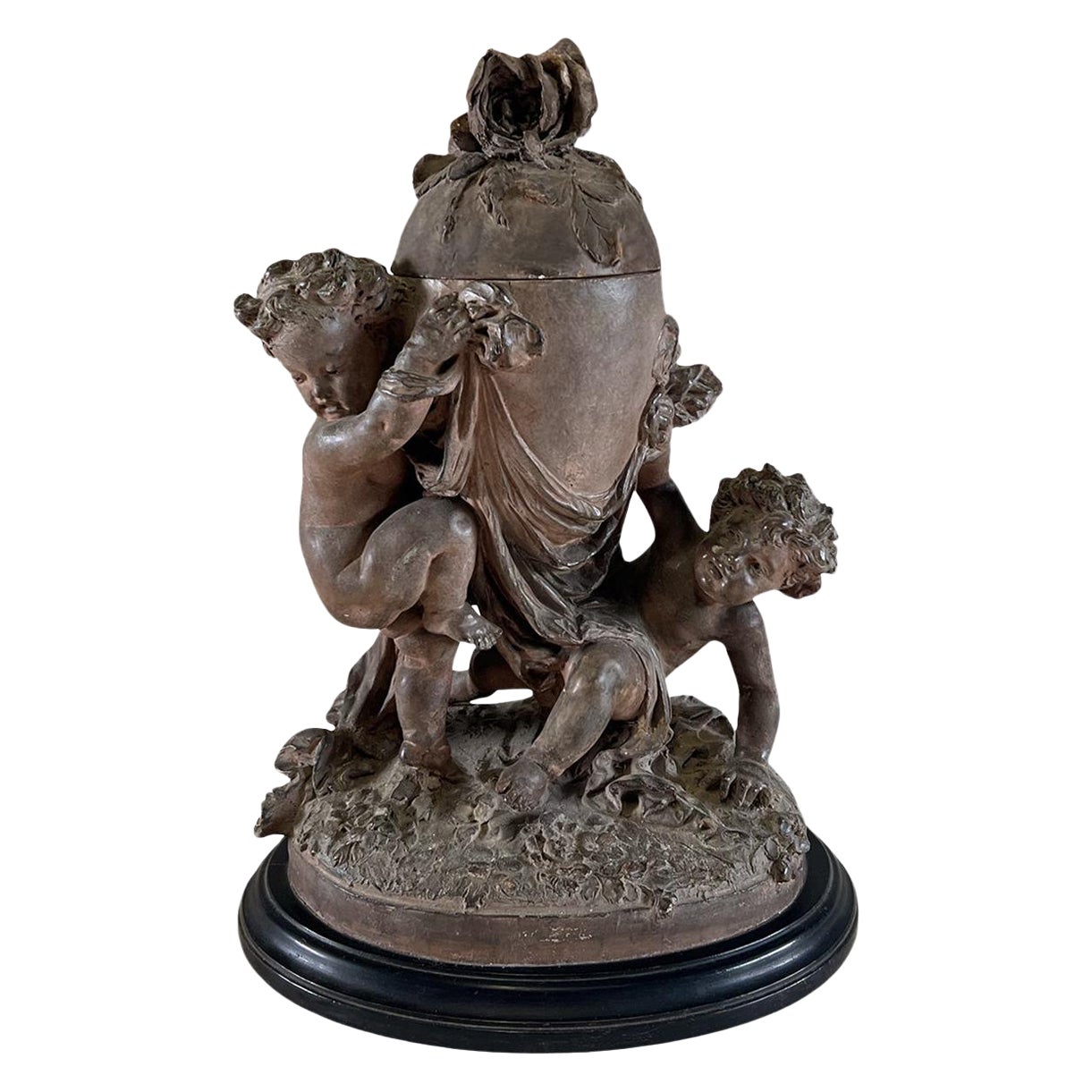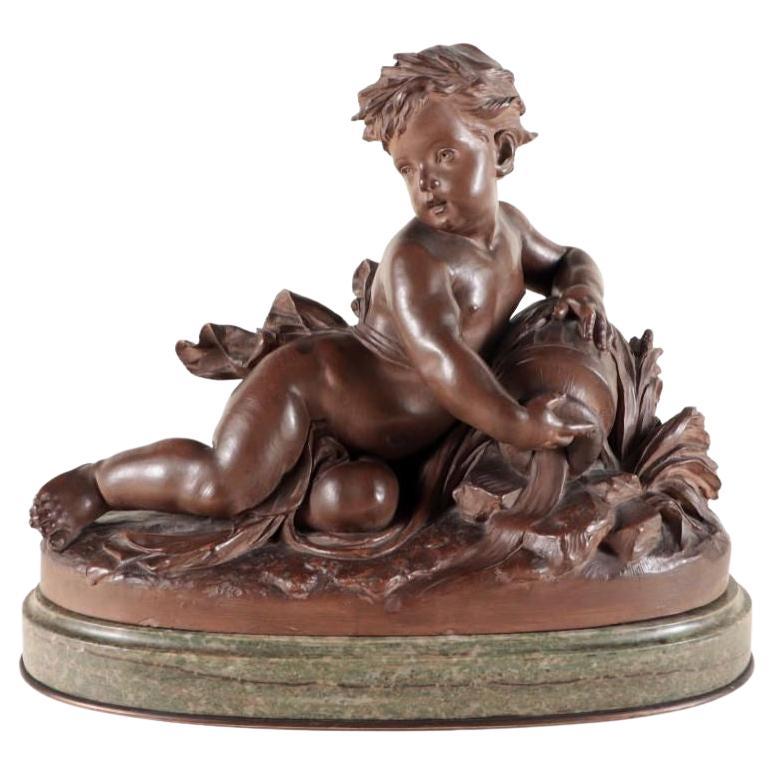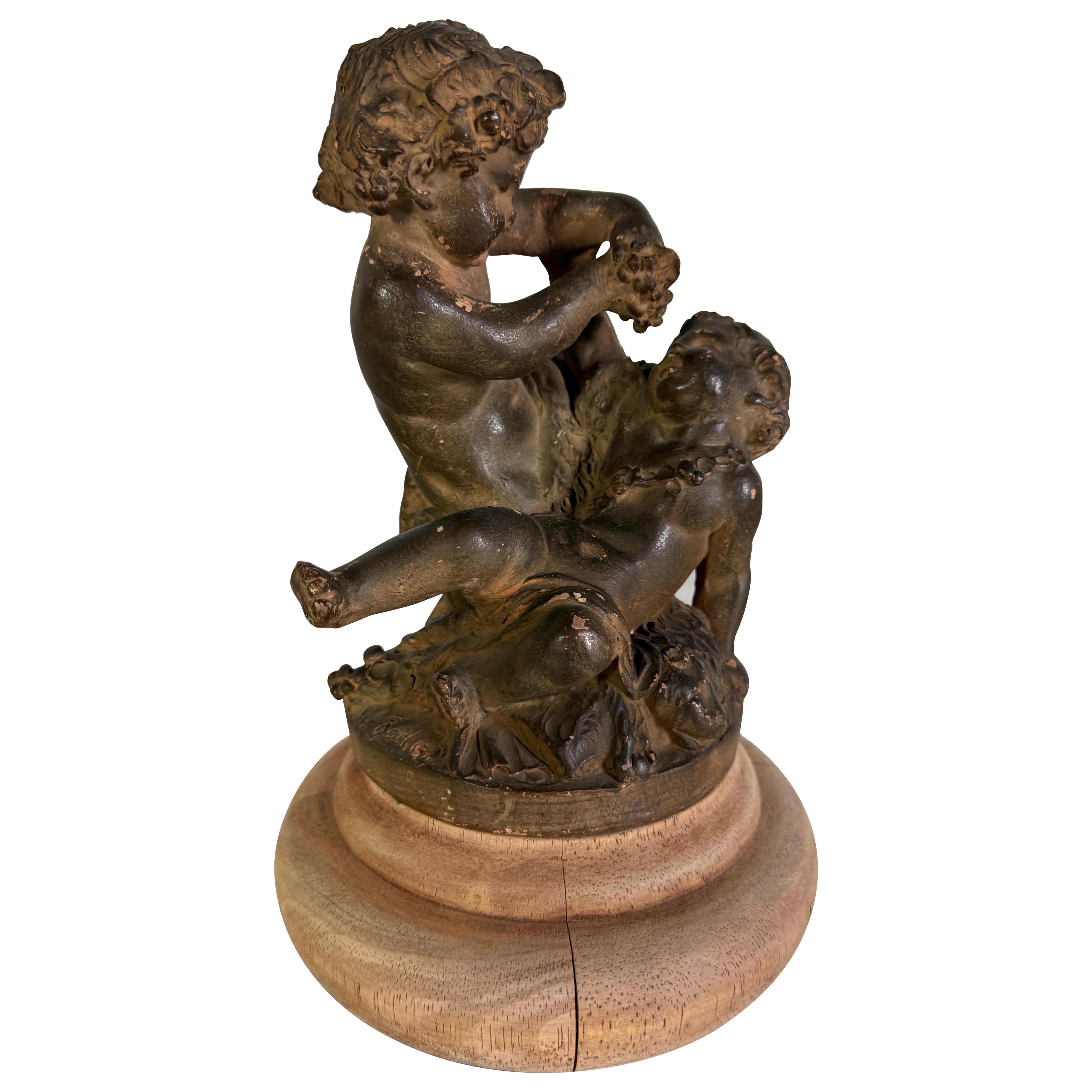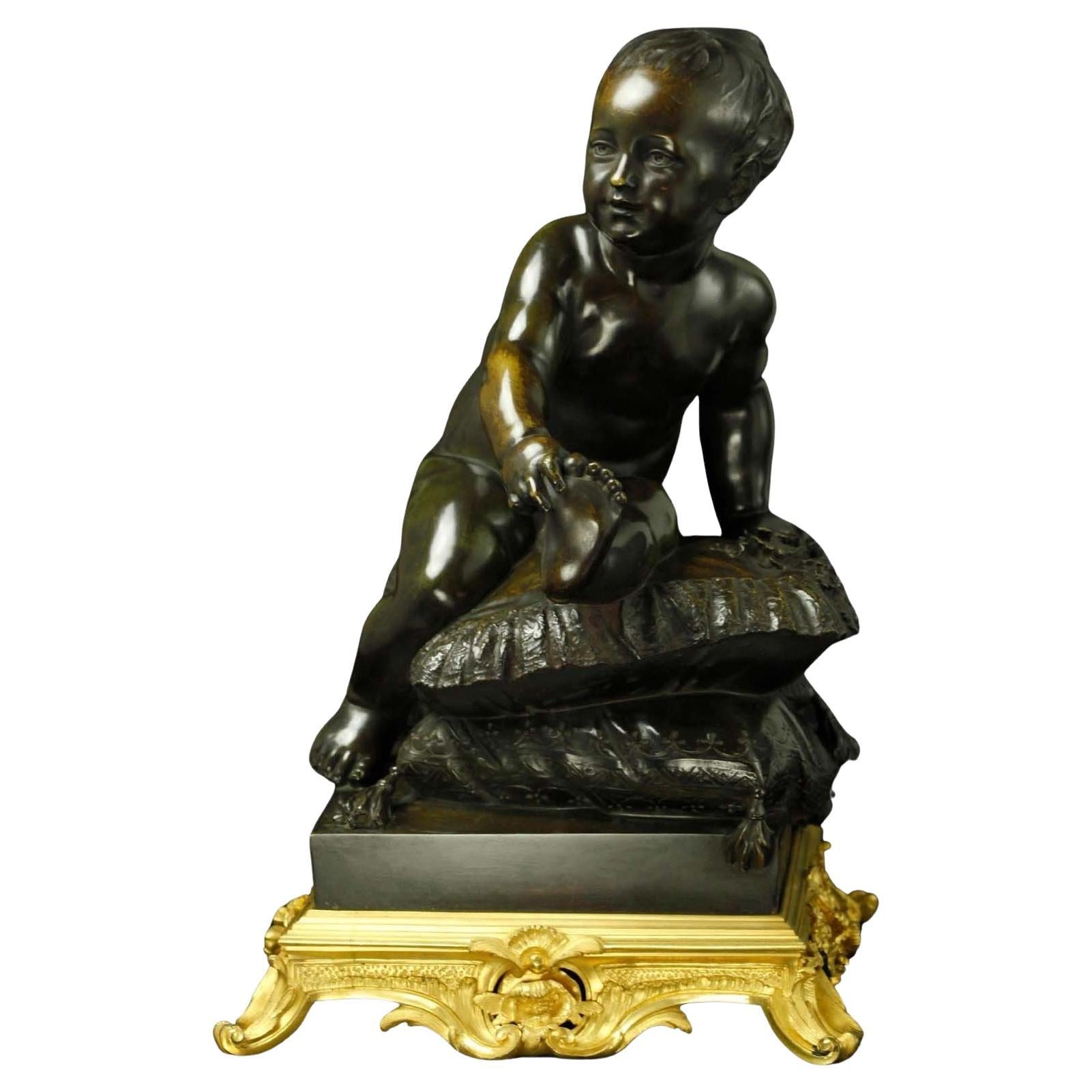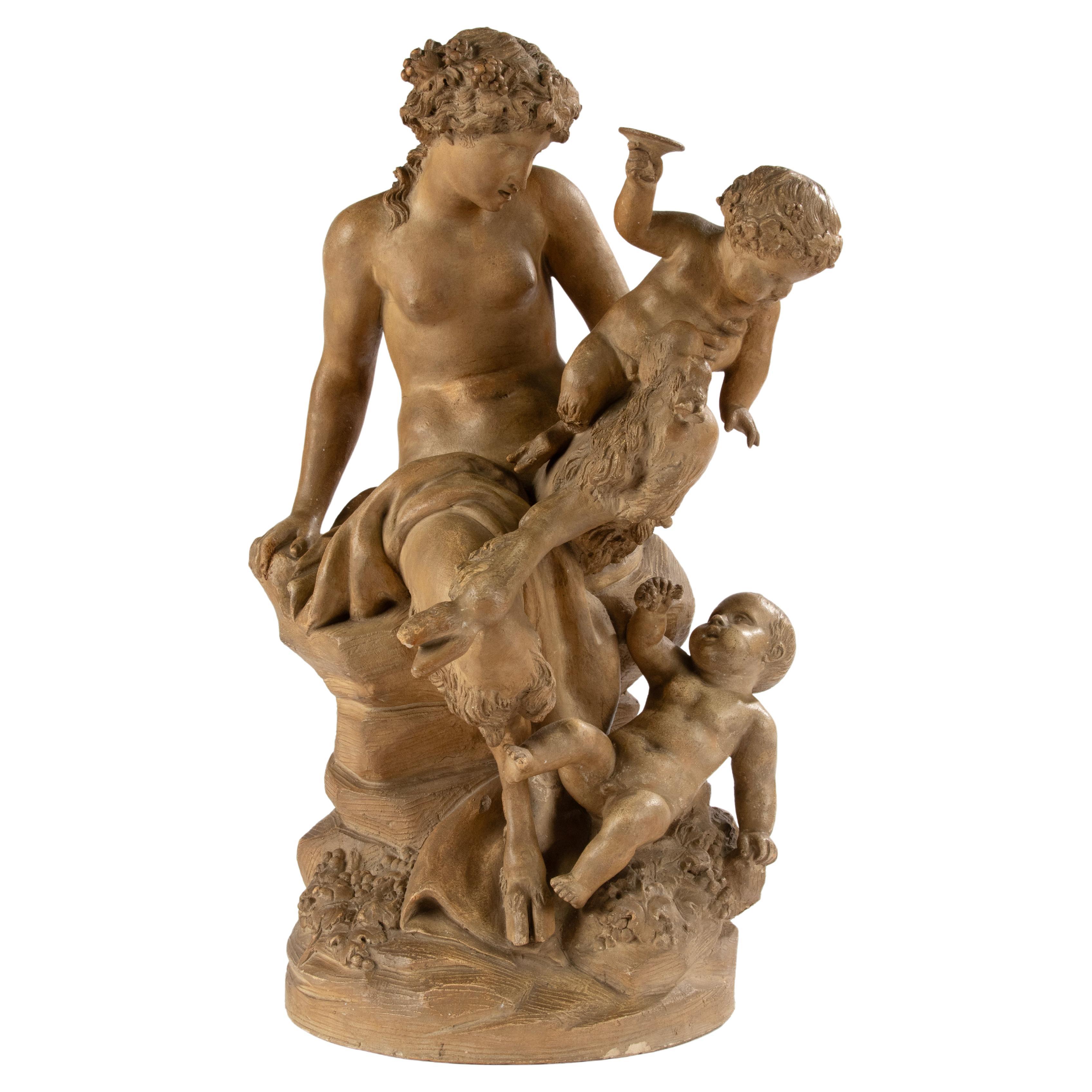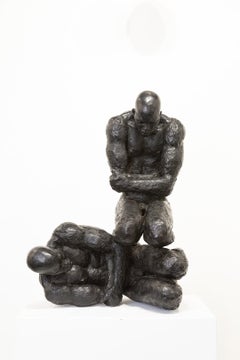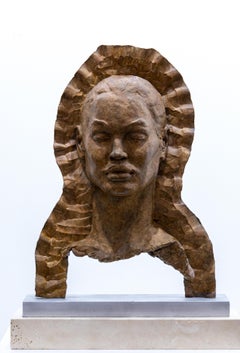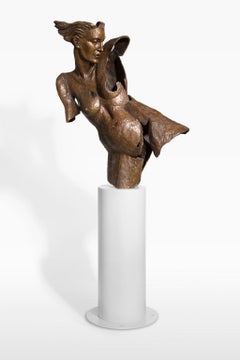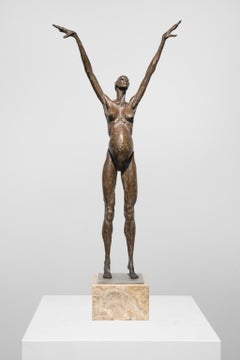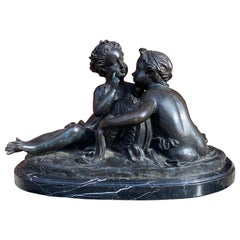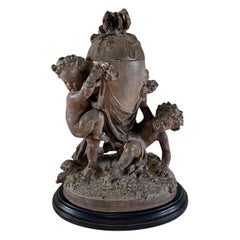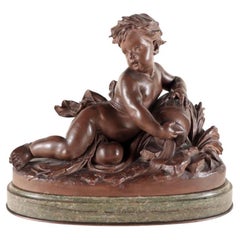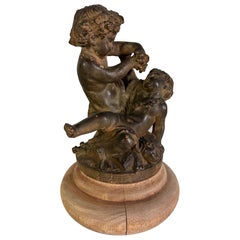Items Similar to "Putti" 19th c. Terracotta, Antique, Mythical Figures, Patina
Want more images or videos?
Request additional images or videos from the seller
1 of 6
Albert-Ernest Carrier-Belleuse"Putti" 19th c. Terracotta, Antique, Mythical Figures, Patina1864
1864
$9,500
£7,174.02
€8,213.59
CA$13,416.48
A$14,647.59
CHF 7,679.13
MX$177,900.60
NOK 95,899.85
SEK 90,555.03
DKK 61,305.72
About the Item
“Putti” is a 19th c. terracotta antique of two nude children, babies, as mythical figures. This piece is beautifully rendered with a rich brown patina. Though babies they seem more mature with their decorative flowers and posed as partaking in conversation. Putti are human (no wings) and male (biologically correct). They are not associated with death. So, the Raphael figure, having wings, is no putto. Second, winged genderless children are cherubs, or more properly, cherubim. This piece is signed by the sculptor and his marks, fingerprints, are on the base of the sculpture which sits on a beautifully carved wooden plinth.
Carrier-Belleuse had a sharp sense of how to combine historical elements with new technologies and the process of mass production. In his workshop, students like Auguste Rodin learned the value of series, editions, and variations made alongside unique, monumental Salon submissions.
Albert-Ernest Carrier-Belleuse (born Albert-Ernest Carrier de Belleuse) was a French sculptor, one of the founding members of the Société Nationale des Beaux-Arts, and an officer of the Legion of Honour. He attended the National School of Fine Arts and began his training as a goldsmith's apprentice. In 1840 Pierre-Jean David d'Angers sponsored him for the École des Beaux-Arts. He stayed only briefly, moving to the Petite École to study decorative arts instead. While at the Petite Ecole in the 1840s, Carrier-Belleuse began his lifelong practice of providing commercial houses with models for edition, as statuettes or as ornament for functional pieces. Between 1850 and 1855, Carrier-Belleuse worked in England, designing ceramics and metalwork models for companies like Wedgwood Minton Chica Works at Stoke-upon-Trent, Coalbrookdale Ironworks and Graham & Jackson furniture makers. Even after returning to Paris in 1855, he continued to send models to British firms throughout his life. From 1857 he exhibited large-scale sculptures at the Salon, where he garnered medals and commissions from important patrons. Emperor Napoléon III employed him in public projects during the massive rebuilding of Paris from 1851 to 1870.
His work encompassed all manner of sculptural subjects and materials, and his naturalism incorporated a breadth of styles: unembellished Realism, neo-Baroque exuberance, and Rococo elegance. He consistently opposed, however, the static poses and idealizing tendencies of Neoclassicism. His torchères for the Paris Opéra were typical: he combined figures inspired by sixteenth-century sculptors with electrotyping, a new process for replicating three-dimensional objects. Beginning in 1876 Carrier-Belleuse revitalized the Sèvres porcelain manufactory as its artistic director.
He began to garner acclaim as a fine-arts sculptor after ten years of showing in the Salon, beginning with two portrait medallions in 1850 and a flurry of busts and groups with mythological or historical subjects between 1857 and 1861, the latter of which earned him a third-class medal. Carrier-Belleuse finally received serious attention in 1863, when the emperor bought his marble Bacchante from the Salon for the Jardins des Tuileries (Musée d'Orsay, Paris). Four years later, his marble Messiah was purchased by the State from the Salon of 1867 and allotted to Saint-Vincent-de-Paul in Paris; it earned him a Medal of Honor and the cross of the Légion d'Honneur. From that time onward, Carrier-Belleuse was established internationally as a high-art sculptor as well. He produced abundantly for a variety of international patrons in most categories of three-dimensional work--public monuments, for example, Masséna (1867, Nice), allegorical reliefs for Parisian buildings (Palais des Tuileries and Banque de France, 1865-1866), tombs for foreign heroes (San Martín Cathedral, Buenos Aires, Argentina), and classicizing figure subjects such as Sleeping Hebe for the Salon (1869, marble; Musée d'Orsay, Paris)--while simultaneously maintaining high visibility in the applied arts.
Carrier-Belleuse raised a critical hue and cry during his lifetime with his sensuous female nudes, especially Angélique, shown in 1866 (marble, lost; reduced terracotta variant, private collection). Broadly in the vein of nineteenth-century "voluptuous antiquity," the work pursues more realism and seductive materiality than Pradier's classical women through their violently sinuous movement and polychromy. Like Auguste Clésinger (1814-1883), who had riveted Paris in 1847 with his Woman Bitten by a Snake (Musée d'Orsay, Paris), Carrier-Belleuse violated the idealist canon of pure marble by adding real jewelry of his famous contemporaries such as Froment-Meurice. However, the sculptor applied his enormous capacity for modeling and design to a variety of stylistic and expressive modes. The neo-baroque realism of his heroic monuments differs signally from the neo-rococo preciousness, material richness, and vivacity for which he is best known. Yet he explored few expressive extremes outside the dionysiac. Open violence and pathos are rare in his work; his most typical expressive mood was the intimate and wittily spirited. He consequently gave varied and winsome life to historical figurines and fantasy busts, and was a masterful portraitist. His prolific portraiture of both men and women is often compared to Houdon's, as it similarly conveys extraordinary likeness and psychological life within richly tactile, modeled work. For all his association with rococo sensuality, Carrier-Belleuse's mastery at articulating form gave as much vitality and appeal to the marbles carved from his models as to his many works in clay and bronze.
The sculptor sold finished serial work directly through his studio and at auction, and thus counted among the most actively entrepreneurial of his fellow professionals, like Jean-Baptiste Carpeaux and his senior, the animalier Christophe Fratin. His models and published designs integrated the human figure within functional forms--torchères and table service, for instance--in a variety of styles, and with imagination and verve; they were commercially successful and influential for decades. Carrier-Belleuse was appointed director of works at the state Manufacture de Sèvres in December 1875, where he greatly improved the quality of the models and expanded production in biscuit. A charter member of the new professional organization for the applied arts (the Union Centrale des Beaux-Arts Appliqués à l'Industrie), founded in the early 1860s, he was enormously important in elevating the stature of the applied arts and for the sheer quality of his ornamental design. For that contribution to France alone the artist was promoted to officer of the Légion d'Honneur in 1885. Thanks to his huge studio production and responsibilities at Sèvres, he had considerable impact on the art and careers of younger sculptors who worked for him, notably Auguste Rodin, whether in Paris or in Brussels, where both moved during the Franco-Prussian War of 1870-1871.
- Creator:Albert-Ernest Carrier-Belleuse (1824 - 1887)
- Creation Year:1864
- Dimensions:Height: 12 in (30.48 cm)Width: 17 in (43.18 cm)Depth: 7 in (17.78 cm)
- Medium:
- Movement & Style:
- Period:
- Condition:
- Gallery Location:Detroit, MI
- Reference Number:1stDibs: LU128616361932
About the Seller
5.0
Vetted Professional Seller
Every seller passes strict standards for authenticity and reliability
Established in 2014
1stDibs seller since 2019
108 sales on 1stDibs
Typical response time: 17 hours
- ShippingRetrieving quote...Shipping from: Detroit, MI
- Return Policy
Authenticity Guarantee
In the unlikely event there’s an issue with an item’s authenticity, contact us within 1 year for a full refund. DetailsMoney-Back Guarantee
If your item is not as described, is damaged in transit, or does not arrive, contact us within 7 days for a full refund. Details24-Hour Cancellation
You have a 24-hour grace period in which to reconsider your purchase, with no questions asked.Vetted Professional Sellers
Our world-class sellers must adhere to strict standards for service and quality, maintaining the integrity of our listings.Price-Match Guarantee
If you find that a seller listed the same item for a lower price elsewhere, we’ll match it.Trusted Global Delivery
Our best-in-class carrier network provides specialized shipping options worldwide, including custom delivery.More From This Seller
View All"Rebirth" Bronze Sculpture with Patina, Figures, Naked, Male
By Artis Lane
Located in Detroit, MI
All my life I have worked on three levels of consciousness: Portraits, Social Injustice & Metaphysics. In my work I strive to heal, uplift and inspire viewers and collectors to find ...
Category
1990s Contemporary Figurative Sculptures
Materials
Bronze
"Madonna" Bronze Sculpture with Patina, Marble base, Figurative, Female
By Artis Lane
Located in Detroit, MI
All my life I have worked on three levels of consciousness: Portraits, Social Injustice & Metaphysics. In my work I strive to heal, uplift and inspire viewers and collectors to find ...
Category
Late 20th Century Contemporary Figurative Sculptures
Materials
Marble, Bronze
"Resonance" Bronze Female Nude Sculpture with Powder Coated Steel Base
Located in Detroit, MI
“Resonance” references Greek classical sculpture and modernist traditions. The female from is depicted as a fragment, introspective and animated. The surface of the sculpture is rich...
Category
Early 2000s Contemporary Nude Sculptures
Materials
Bronze, Steel
"Wise Virgin I (Celebration)" Bronze Sculpture, Figurative, Nude Pregnant Female
By Artis Lane
Located in Detroit, MI
All my life I have worked on three levels of consciousness: Portraits, Social Injustice & Metaphysics In my work. I strive to heal, uplift and inspire viewers and collectors to find ...
Category
Late 20th Century Contemporary Figurative Sculptures
Materials
Bronze
"Woman" Bronze Sculpture with Patina, Female Nude
By Artis Lane
Located in Detroit, MI
All my life I have worked on three levels of consciousness: Portraits, Social Injustice & Metaphysics In my work I strive to heal, uplift and inspire viewers and collectors to find p...
Category
Late 20th Century Contemporary Figurative Sculptures
Materials
Bronze
Price Upon Request
"Birth" Sculpture, Bronze with Black Patina, Female, Nude
By Artis Lane
Located in Detroit, MI
"Birth" is a small intimate sculpture of a women in the act of pending birth. She gazes skyward beyond her own condition of birthing an earthly being, to encompass the intellectual a...
Category
Late 20th Century Contemporary Nude Sculptures
Materials
Bronze
Price Upon Request
You May Also Like
Antique Bronze Putti on Marble Base styled after Albert-Ernest Carrier-Belleuse
By Albert-Ernest Carrier-Belleuse
Located in Chicago, IL
Antique Bronze Putti Sculpture on Marble Base styled after Albert-Ernest Carrier-Belleuse
Albert-Ernest Carrier-Belleuse (1824-1887) created the sculpture known as the, “Allegorie d...
Category
Antique Late 19th Century Unknown Baroque Revival Figurative Sculptures
Materials
Marble, Bronze
19th Century French Antique Terra Cotta Cherub Figurine Statuette Objet d’Art
Located in West Palm Beach, FL
This antique, elegant early 19th Century allegoric figure composition was hand crafted in terracotta clay and placed on an oval wooden base, in good condition. Two cherubs are drapin...
Category
Antique Early 19th Century French Louis XVI Figurative Sculptures
Materials
Clay, Terracotta, Wood
Cherub with Water Jug Terracotta Sculpture on Verdigris Marble Base
Located in New York, NY
Cherub with water jug Terracotta sculpture on Verdigris marble base after a model by Albert-Ernest Carrier-Belleuse. Apparently unsigned.
Category
Antique Late 19th Century Neoclassical Figurative Sculptures
Materials
Marble
19th C. French Terra Cotta of Putti’s
Located in Los Angeles, CA
This is a charming 19th century French terracotta sculpture depicting two playful putti in a spirited pose, likely representing allegorical or pastoral themes common to the period. T...
Category
Antique 19th Century French Rococo Figurative Sculptures
Materials
Terracotta, Wood
French 19th Century Putti Bronze Sculpture by Coustou
By Coustou
Located in Los Angeles, CA
Endearing patinated bronze sculpture depicting a young putti sitting on a pair of cushions and. supported by a D'ore bronze base with floral motif designs. Signed "Des Coustou" and a...
Category
Antique 19th Century French Figurative Sculptures
Materials
Bronze
Antique Terracotta Bacchanale Sculpture with Faun and Putti - After Clodion
By Claude Michel Clodion
Located in Casteren, Noord-Brabant
A fine quality French mythological terracotta sculpture, after Clodion (Claude Michel Clodion 1738 - 1814), depicting a young female faun/satyr playing with two Bacchante cherubs, on...
Category
Antique 1890s French Rococo Figurative Sculptures
Materials
Terracotta
More Ways To Browse
19th Century Terracotta Sculpture
Putti Sculpture
Carrier Belleuse
Late 19th Century Bronze Sculpture Of A Woman
Portrait Medallion
Alberts Antiques
Albert Ernest Carrier Belleuse
Baroque Putti
Neo Rococo
Nude Wood Sculptures
Wood Putti
Albert Wood
A Carrier Belleuse
A Carrier Sculpture
Jean Baptiste Carpeaux
Sevres Style Porcelain Three Piece
Figural Torcheres
19th Century Male Nude Bronze

